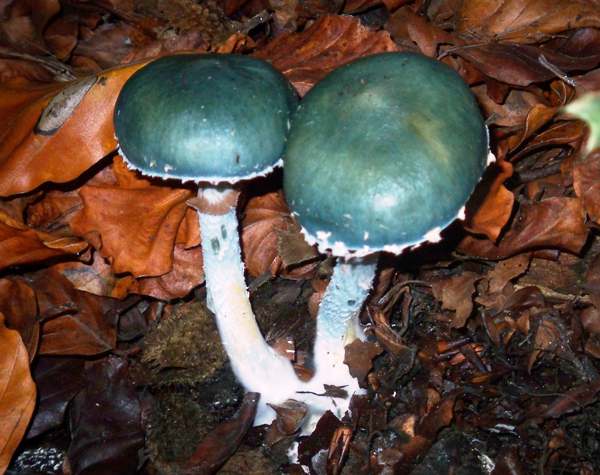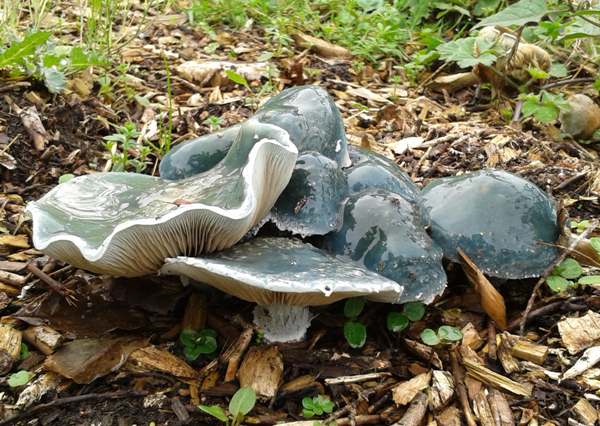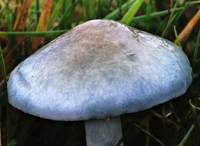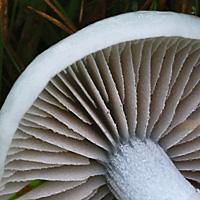Trees Birds Mammals Fish Amphibians Reptiles
Wild Algarve
Bookshop
Stropharia aeruginosa (Curtis) Quél. - Verdigris Roundhead
Phylum: Basidiomycota - Class: Agaricomycetes - Order: Agaricales - Family: Strophariaceae
Distribution - Taxonomic History- Etymology - Identification - Culinary Notes - Reference Sources

Stropharia aeruginosa is one of very few blue-green
fungi. (In most instances the caps are much nearer to green than to blue, but when young and fresh they are very beautiful and quite startling.) The caps, initially bell-shaped, flatten and turn paler from the
centre. White scales adorn young caps of this remarkable
fungus.

Distribution
This attractive mushroom is a rare find and very localised in Britain and Ireland, occurring mainly in alkaline areas of humus-rich Beech woodland and parkland. These striking mushrooms are found throughout mainland Europe and they are also recorded in parts of North America.
Taxonomic history
Although this blue mushroom has been known to science for more than two centuries, its separation from Stropharia caerulea had not been clearly defined until, in 1979, the German mycologist Hanns Kreisel (b. 1931) published a paper in Sydowia (an international Mycological journal produced in Austria), which established Stropharia caerulea as a distinct species.
The basionym of this species was created when the Verdigris Roundhead was described in 1782 by British naturalist William Curtis (1746 - 1799), who gave it the binomial scientific name Agaricus aeruginosus. It was French mycologist Lucien Quélet who, in 1872, established the currently-accepted scientific name of this species as Stropharia aeruginosa.
Synonyms of Stropharia aeruginosa include Agaricus aeruginosus Curtis, and Pratella aeruginosa (Curtis) Gray.
Etymology
Stropharia, the genus name, comes from the Greek word strophos meaning a belt, and it is a reference to the stem rings of fungi in this generic grouping. The specific epithet aeruginosa means deep blue-green.
Identification Guide
 |
Cap
Young caps are bell-shaped, blue-green and
slimy, peppered with small white veil fragments. Older specimens, like the
one illustrated here, are paler and often lose the white scales from the rim of the cap,
which expands but does not completely flatten out. In sunlight the slime dries up on
older caps, which gradually turn pale tan from the centre outwards.
The cap diameter at maturity ranges between 2.5 and 8cm. |
 |
Gills
At first pale grey, the moderately crowded adnate gills
become purple-brown as the spores mature.
The gill margins (see left) remain white, which helps distinguish the Verdigris Roundhead Stropharia aeruginosa from the more commonly encountered Blue Roundhead Stropharia caerulea, whose gill edges gradually turn brown along with the gill faces.
Stem
Whitish above the ring, which is transient and soon discoloured brown by falling
spores; darker blue-green below the ring zone and peppered with coarse white scales. 5 to 12
mm in diameter and 2 to 6cm tall. |
| |
Spores
Ellipsoidal, smooth, 7.5-9 x 4.5-5μm, with a germ pore.
Spore print
Purple-black. |
Odour/taste |
Not distinctive. (Caution: probably
poisonous.) |
Habitat & Ecological role |
Saprobic, usually in small groups among grass and occasionally
leaf litter in woodland and in pastures. |
Season |
July to October in Britain and Ireland; up to three months later in southern Europe. |
Similar species |
Stropharia caerulea is paler blue-green and its cap scales are usually evident only on young fruitbodies; it has brown gills without white edges. In Britain this species is much more common than Stropharia aeruginosa .
Clitocybe odora is also blue-green but does not have a slimy
cap with scales; it has a strong odour of aniseed. |
Culinary Notes
Together with other fungi in the genus Stropharia, the Verdigris Roundhead is inedible. In the USA it is listed by several authorities as one of the mushrooms that can contain significant amounts of the toxic hallucinogens psilobin and psilocybin. Although, with the possible exception of Sulphur Tuft Hypholoma fasciculare, no member of the family Stropharicae is known to be dangerously poisonous, some of the Stropharia species can certainly cause very unpleasant gastro-intestinal symptoms. We therefore treat Stropharia aeruginosa as just for looking, and definitely not for cooking.
Reference Sources
Fascinated by Fungi, 2nd Edition, Pat O'Reilly 2016, reprinted by Coch-y-bonddu Books in 2022.
BMS List of English Names for Fungi
Dictionary of the Fungi; Paul M. Kirk, Paul F. Cannon, David W. Minter and J. A. Stalpers; CABI, 2008
Taxonomic history and synonym information on these pages is drawn from many sources but in particular from the British Mycological Society's GB Checklist of Fungi.
Acknowledgements
This page includes pictures kindly contributed by Janet Hill.
Top of page...
Fascinated by Fungi. Back by popular demand, Pat O'Reilly's best-selling 450-page hardback book is available now. The latest second edition was republished with a sparkling new cover design in September 2022 by Coch-y-Bonddu Books. Full details and copies are available from the publisher's online bookshop...